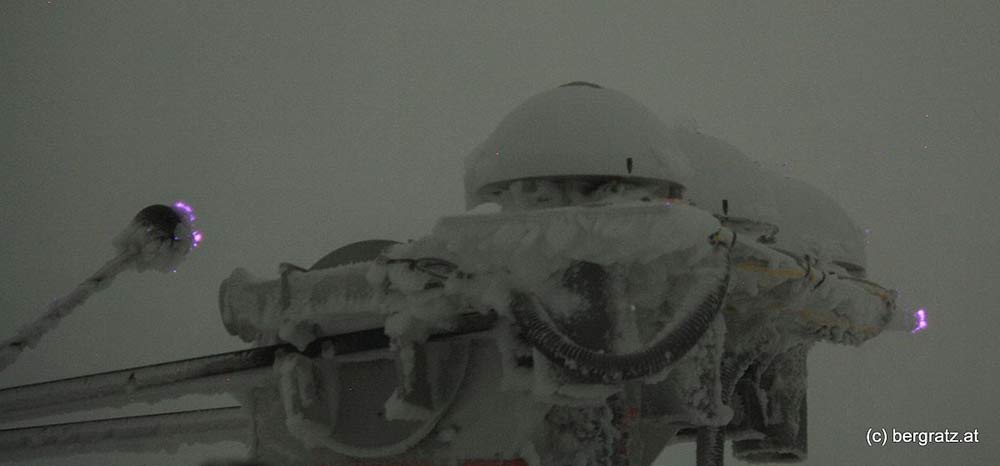How St. Elmo’s Fire Works?

If you have ever voyaged across the sea or flown through a thunderstorm, you might have seen a bluish glow that closely resembles a sustained spark. It’s a phenomenon called as St. Elmo’s fire. The name ‘St. Elmo’s fire’ is just a ridiculous historical name given to the phenomenon and it really has nothing to do with fire. Hence, it is neither a fire nor a lightning. It is more of a static discharge. Before we see how St. Elmo’s fire work, it is essential to do a quick review on how lightning works.
Lightning
As in nature, when a storm develops, clouds are charged due to the collisions of the atoms inside the clouds. The upper part of the cloud is positively charged while the lower part of the cloud is negatively charged. This high concentration of the negative charge at the bottom of the clouds repel the electrons in the atoms at the ground and polarizes the ground positively. As the concentration of the negative charge around the clouds gives rise to an intense electric field, the air around the region gets their electrons ripped off from them, forming a plasma zone. This also happens so that the charge separation in the clouds neutralizes in some way. Besides, this is indeed how lightning begins to form. The ionization continues to grow as long as the electric field intensity is higher. It forms a conduit of plasma (called as leaders or downward streamers) so that the electrons can flow towards the ground.
In the ground, the same happens. Except the concentration of positive ions would be more concentrated at tall rods and sharp objects like a lightning rod. The air ionizes around it and it creates an upward conduit (upward streamers) at a slower rate. These conduits are plasma that is so ready to conduct electric current better than their previous phase. Therefore, when the downward conduit and the upward one meet each other, the circuit is complete and lightning strikes.
St. Elmo’s fire
Now that you know how lightning works, explaining the St. Elmo’s fire phenomenon is quite easy. Besides, if you know how a neon light works, you could figure it out yourselves. On the ground, during a thunderstorm, say a mast of the ship, a tall post of any house, or even the sharp corners of any structure, acts as a possible lightning rod. A tall pointy structure with reduced surface area gives the lightning a chance to discharge with a less resistive path to the ground.
What does it have to do with the St. Elmo’s fire phenomenon? Well, the way lightning rod works is that it ionizes the air around it, as its positive polarity attracts (tears) the electrons off the atoms whose protons are already being attracted by the negatively charged clouds (and repelled at the same time by the lightning rod). This ionization tries to neutralize the cloud at the bottom. However, under certain conditions, when the charge density is higher in the clouds, an equal higher density of positive charge on the earth front is created and even higher positive ions accumulate at the tall objects like the lightning rods or masts of the ships. Therefore, this very high electric potential difference ionizes the air in a slightly different way. As the voltage is too high, the energy of the free electrons is so high around the pointy objects that it makes them collide with other neighboring atoms and rip their electrons further. When electrons with higher energy recombine with the positive ions and return to a lower energy state, this produces a visible corona around the object, which possibly luminesces the plasma. The color of the corona is governed by the atmospheric contents. In our case of Earth, it’s primarily Oxygen and Nitrogen. Hence the blue colors.

St. Elmo’s Fire at Sonnblick Observatorium, Austria. Photo by Hermann Scheer | CC BY-NC-SA
This sustained corona discharge (St. Elmo’s fire) would continue producing this luminous plasma with a hissing sound as long as the electric potential difference between the clouds and the earth is greater than 1000 – 30,000 volts per centimeter, which is the required voltage for our atmospheric air to produce this kind of discharge. When you see one such glow around some tall posts or objects, there is a very high probability that a lightning (arc discharge) is about to strike. Sometimes, this faint corona is observed around the pointy horns of some animals. Besides animals, this is more commonly observed in the wing tips and the nose of an airplane flying through the clouds.
This post was first published on October 15, 2015.











Lightnings, especially ball lightnings and St.Elmo’s fire are highly speculative subjects. I like the way you have written it avoiding all the unexplored pitfalls. Job well done!
I don’t get the ‘unexplored pitfalls’ part. But thank your for your appreciation. :)
Lightnings aren’t understood fully yet.
Indeed.
Easy to understand the concept. Well explained Karthik.
Thank you. :)
I have never seen a St. Elmo’s fire photographed this close.
It was actually recorded on a webcam. You could find more pics here – http://www.foto-webcam.eu/webcam/sonnblick/.